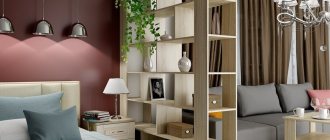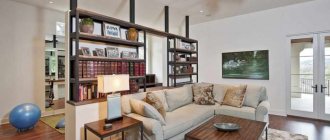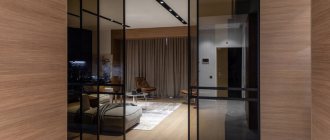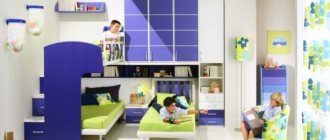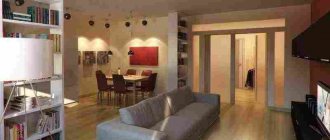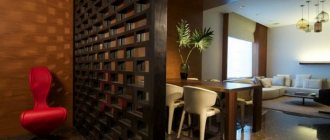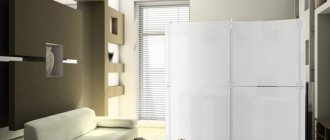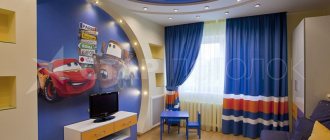When there is a need to redevelop a single room or an apartment as a whole, decorative partitions can come to the rescue. Because they not only perform an aesthetic function in the interior, but also serve as an excellent tool for zoning. The original layout could have been extremely unsuccessful: small rooms were claustrophobic, and large ones were too uncomfortable and too spacious. In such cases, partitions allow you to rationally use the usable area and correctly delimit the space. And the design execution of these practical products guarantees that the interior will be transformed beyond recognition. Sometimes this is the only right decision that a home owner can make to achieve comfort. Next, we will consider the main characteristics and options for their application.
Functions of decorative partitions
Partitions create a certain atmosphere: they will add coziness and warmth, making the zones more secluded, they will allow you to create an office inside the apartment for quiet work remotely, they will isolate the children's corner with eternal chaos from the common living room.
Decorative partitions look interesting; the texture and material allow you to create accents in the room or, conversely, hide unnecessary corners. Among the “advantages” of the decorative elements of the room, designers highlight the durability of the structure and environmental friendliness of the materials.
Among the disadvantages, the high cost of certain types of decor, as well as insufficient sound insulation of the partition, are often cited.
The use of decorative products in a modern interior
The choice of suitable decorative elements directly depends on the room that needs to be decorated. Based on its parameters, functional tasks and general style, the selection of one or another type of decorative partitions should be carried out. The shape of the products should also take into account the characteristics of the given space.
Among the advantages of using this decorative element are the following:
- Aesthetics and originality of execution;
- Wide range of materials used;
- No restrictions for design ideas;
- Long service life;
- Environmental aspect.
Disadvantages include poor sound insulation or the relatively high cost of some models. Depending on the layout, there are two main types of decorative partitions in the interior:
- Partitions for zoning a room;
- Interior partitions in the interior.
Partitions can be sliding (rotating) or stationary. The former are often used as interior sliding doors on roller rails.
Shapes of decorative partitions
- Radius partitions have rounded corners, creating a pleasant semicircle in space. Semicircular partitions equipped with mirrors or glass enlarge the space, giving it a zest.
- Traditional rectangular shaped partitions give the design a classic look. The height of the partition can be up to the ceiling or just 1.5 m. The choice depends on the desire to completely hide the space or slightly veil some of the corners.
- Arched partitions are an original architectural structure that adds lightness to the room.
- Curly partitions allow you to zone a room in non-standard ways, creating semicircular or other fantasy images.
- The “ladder” partition allows you to slightly open the space, but the main part will be neatly covered.
Partitions for the living room
The living room has always been a multifunctional place: they welcome guests, spend quiet family evenings, sometimes work or even sleep. It is necessary to provide for the possibility of using the living room for different purposes.
Designers recommend using decorative screens or glass partitions to separate the seating area and the kitchen corner where food is eaten. It is important to match the color of the partition to the tone of the walls so that the space looks unified and harmonious.
- For a living room where many books are stored, a partition-rack would be relevant, containing all the book editions and other decorative elements of the interior (figurines, photographs).
- A partition with an aquarium will be a luxurious addition to the living room. Soft lighting and the sound of water will add peace to the space. In this case, the room will be visible from all sides.
Types of partitions and their properties
Let's look at the most interesting types of glass room partitions. According to the type of processing, the material can be of 5 types. Glass can be tinted, matted, sandblasted, chemically etched and cut into patterns.
Stained glass windows can be painted with patterns, drawings and appliqués. Decoration is also carried out by applying a special film in the form of applications. Ideas vary and depend on customer preferences.
Unusual decorative partitions are also made from other materials:
- Wood (chipboard);
- Gypsum vinyl;
- Drywall;
- Plastic.
Different types of partitions have certain properties and parameters.
Partitions can be:
- Transparent;
- Lightproof;
- Soundproofing, etc.
The designs can be based on an aluminum profile or frosted glass. Quick-install partitions are durable and come in a variety of thicknesses and styles. Products made from chipboard look natural and give the room warmth and comfort. However, they slightly clutter the space, which cannot be said about glass partitions.
Shelving partitions are often installed in the living room. Thanks to them, a functional space (zones) is created into which light penetrates. Therefore, experts recommend using this type of partition in dimly lit living rooms. Stationary partitions are mounted either as separate blocks or as one solid structure with a durable metal frame.
If your living room is small, you can consider the option of shelving structures without a back wall and doors. For more spacious living rooms, partitions with built-in lockable cabinets are suitable. This is a good way to increase your storage space.
Glass partitions are the best alternative to other types
When choosing and installing partitions in a room, you should think about the consequences. Some materials lose their appearance over time. For example, fungus can develop on drywall. When installing wooden structures, you need to remember that they are susceptible to moisture. Therefore, it is not advisable to install them in rooms with high air humidity.
Glass partitions, as an idea for zoning, do not lose their aesthetics after decades. They do not form fungi and bacteria on the surface, which means they will serve for a long time without losing their properties and functionality.
Beautiful partitions are appropriate in any interior
The workspace can be separated from the general space by unusual decorative partitions. This alternative zoning method is the most correct. Thanks to a large selection of types of designs, you can turn a small studio apartment into a modern apartment with several comfortable rooms. If you use glass partitions, you will be able to visually make the room more spacious and wider. The material will add lightness to the rooms and make your interior elegant.
Bedroom partitions
In small apartments it is important to use every meter, so often the bedroom is turned into an office or workshop. To divide the space, shelving-type partitions are used, where shelves are used to place office supplies, books, diaries and other work utensils.
- To create a secluded work environment, designers recommend installing a partition cabinet.
- Not only will the zones be separated, but there will also be space for storing bedding and belongings.
- Screens and decorative screens in a variety of colors and materials will allow you to hide your workplace without stealing too much square footage from the bedroom.
- Screens and screens can be easily moved, folded completely and stored in a corner if the need arises.
For a small bedroom adjacent to a bathroom, a glass partition would be an interesting project. The space will become visually larger, and the bathroom will become part of the bedroom.
If the room has a workshop, then the sleeping area can be easily separated with curtains: thick curtains, Japanese-style curtains, weightless tulle - any fabric will allow you to create an individual space with a unique style.
In addition, as experts note, curtains remain the cheapest way to transform a space by dividing it into zones.
Making decorative elements with your own hands
You can make partitions yourself, but without the right tools it will be extremely difficult. The simplest material for making a decorative element is plasterboard. As an example, let’s look at the procedure for creating a stationary partition to divide space into zones.
- Marking. A plasterboard profile up to 5 cm wide is laid on the floor and then outlined with chalk. The workpiece is attached at a distance of one cm from the outlined line;
- In the same way, markings for racks are carried out;
- The profile, about 2 m high, is fixed to the wall using self-tapping screws;
- Temporary jumpers are marked for further installation of shelves;
- The frame of the proposed design is sewn up (a width of up to 25 cm is recommended). To do this, whole sheets of drywall are carefully trimmed on each side. The remains will then be used for cladding the ends;
- The perforated corner is fixed using a stapler;
- Finishing is carried out in two stages: reinforcing, then finishing.
You can make this decor yourself.
Subsequently, the finished partition structure can be decorated at your discretion.
Unusual luminous screen made of branches and garland
Partitions for the kitchen
In the kitchen, the cooking area is usually separated from the dining area. For this purpose, universal shelving can also be used, where kitchen utensils will be placed instead of books.
- A decorative partition will not only delimit zones, but also create new storage spaces.
- If the room is in a loft style, then it is recommended to boldly use wide wooden beams or wrought iron shelving with glass shelves.
- Brick partitions will also fit perfectly into a loft-style kitchen, but you need to carefully calculate the placement of the wall: Brick cannot simply be dismantled later.
Designers recommend building a fireplace or an aquarium into plasterboard partitions, which will create a peaceful atmosphere in the eating area. Walls made of glass blocks of different colors and textures will allow you to create a partition of different heights.
Glass perfectly transmits light, while simultaneously hiding personal space from prying eyes. Glass partitions are often used in bathrooms.
The use of partitions depending on the purpose of the rooms
Living room
The multifunctionality of this room puts forward its own requirements for the organization of space. Because not only a festive reception of guests is held here, but also often a family dinner. All family members gather to discuss their interests. Therefore, it is necessary to satisfy their potential needs as fully as possible. It is even possible to use several decorative partitions.
Before installing the product, you need to make sure that the location for its placement is chosen correctly.
It is recommended that you read articles about modern interior design, where various room zoning options may be offered. The arguments given there may influence future planning. For example, you can separate the dining area and the sitting area with an elegant screen or a stylish glass partition. The use of specific materials should be guided by the general color scheme of the living room and the type of furniture set.
Another option for placing many different accessories, flowers or books can be a decorative partition - a rack. The comfort that it can provide allows you to fill the modern interior of the room with real comfort. A similar effect can be achieved when used as a partition - a decorative, built-in aquarium. Since its sides will be open to both zones, it will be able to accomplish the difficult task of decorating each zone while keeping them separate from each other.
Bedroom
Often, in small apartments it is necessary to combine a bedroom with a study. Lack of space has an acute impact on the overall feeling, which leads to the impossibility of both relaxation and fruitful work.
The use of decorative partitions helps solve this problem. Screens of various shapes provide privacy for each member of a married couple.
Translucent carved partition between the living room and bedroom
Kitchen
The main function of the partition in this room is to delimit the space for cooking and eating. Partitions in the kitchen interior stylishly enhance the dining area, while at the same time improving the practicality of the food preparation area.
A wire screen on a wooden frame seems to be very convenient to use. It is used to place kitchen accessories, and maintenance of galvanized material is extremely simple. Such a decorative partition can have a variety of shapes.
Children's room
Here you will need a division into three functional zones: for relaxation, study, and a playground. Such zoning allows you to leave the mess in the place provided for it. The other space will be used for practical educational purposes. Often, for such interior organization, a decorative partition of a box-shaped design is used in order to additionally be able to fill it with something useful.
Partitions for children's rooms
Rooms for children should contain 3 main areas: a play corner, an area for sleeping and relaxing, and a study. Sometimes it seems that it is impossible to combine all this, but a competent combination of decorative partitions will create a unified style for such different spaces.
- Shelving-type partitions will allow you to place all the child’s toys, separating the bed from the play space.
- The work desk can also be easily fenced off with curtains or glass blocks, which will actively transmit light, but at the same time create a working atmosphere in the learning area.
Sliding and mobile partitions are not recommended for use in children's rooms, so that the child does not accidentally knock over decorative elements. Partitions must be securely fastened.
There are many ways to divide space with decorative partitions. It is necessary to decide on the budget, the location of the partition and its purpose. Then choosing a decorative partition to suit any design will not be difficult.

